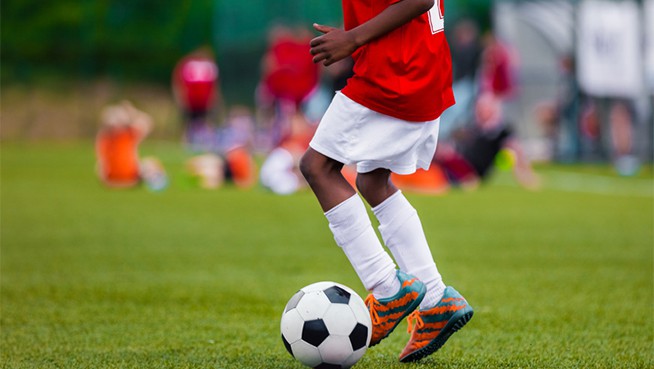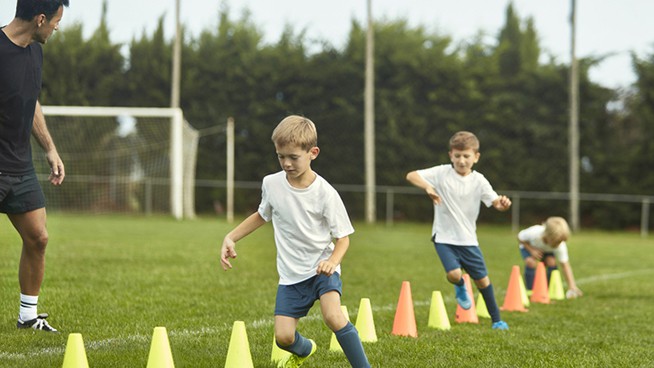New Approach to German Youth Soccer
One of the problems with youth sports is that the adult game is modified for the children rather than a true-child-centered approach being taken. This results in too many adult-led tactics at an early age with too few touches of the ball. There is little time for skill development and even less for fun. The bigger, older players in each group tend to dominate, and the rest get left behind. This continues all the way until adult soccer, by which time many younger, smaller, late-developers may have left the organized game.
The German football league has recently changed how they structure youth football to reflect the needs and levels of the children. The game has been radically changed for under-8 and under-7 age groups. The emphasis is on playing with small sides and four goals (yes, four goals) to allow more scoring to take place. The idea is to allow all players to develop and keep more children in the game for longer. The skills and tactics are introduced later on once the child’s ‘touch’ has been developed.
There are many interesting, well-researched ideas that soccer coaches can introduce to their practices even if they can’t change the system. Be warned, if your adult ego is linked to how your young soccer players ‘beat’ other children, then these ideas are not for you!
Smaller sides mean more decision making
Children want to play football: that means kicking the ball and scoring goals. If they play in smaller teams, they are more likely to touch the ball. Many countries have introduced smaller-sided games at young age groups for this reason. The German league has taken it a step further.
For under-6 and under-7 players, the games are 2vs2 and 3vs3 with no goalies. Yes, no goalies. There are four goals, and the pitches are small, up to a maximum of 28m by 22m. Games are recommended to play for a maximum of 10 minutes, with up to two substitutions per team. Instead of one big match, a series of matches is suggested where the winning team moves up a pitch, and the losing team moves down a pitch. This results in more even games and none of the lop-sided thrashing that can demoralize children.
Soccer coaches could incorporate this into training: it is a great way to involve all the players, even if the matches are only 2 minutes each. Do this five times, and you have a great play: rest ratio with lots of touches and high levels of fun.
At under-8 and under-9, the pitches become larger (up to 40m by 25m), and the teams can keep the 3vs3 format or move to five-a-side. The five-a-side option has two goals, with a goalie and four outfield players on each time. There are no throw-ins or goal kicks; the ball is dribbled in. This reduces the chances of players heading the ball and, therefore the risk of head and brain injuries associated with the repeated heading of the ball. The tournament format is still recommended with moving up and down the pitches as the teams win or lose.
There are no league tables. No rankings. The teams win or lose each match, but because of the constant change between teams, no win or loss is too great or is carried for too long.
There are no referees at this stage; the helpers or coaches can arbitrate. If you have a squad of 20 players, think of rotating the teams around in training. You could change the goalie in each match, so no layer is ‘specializing’ too early.
This is what used to happen when children played in parks with their friends. There were no ‘super- teams’ that dominated the afternoon. The other players would simply quit. Instead, players swapped teams until they were almost even. The children played together, realizing that the fun was in the game rather than the result: although everyone likes to score and celebrate.
In under- 10 and under-11 age groups, the pitch sizes increase up to 55m by 35 m, and either 5v5 or 7v7 matches are held. The 7v7 matches are recommended between four teams, with each game being 2 x 12 minutes. Throw-ins are now allowed.
Summary
This format has been discussed for many years. Football associations know that the adult format and winner-takes-all attitude result in players leaving the game. The German association has taken the first step in restructuring the outdated approach and made the game child-centered.
The children can now play and develop at their pace, learning skills and games sense, rather than memorizing rules and tactics. These can be introduced at later stages when the players are ready.
Even if you are stuck in a league, using some of these ideas in your training sessions will allow you to retain and develop more players. You are putting the game into their hands (or feet), where it belongs.
RECOMMENDED FOR YOU
MOST POPULAR
New Approach to German Youth Soccer
One of the problems with youth sports is that the adult game is modified for the children rather than a true-child-centered approach being taken. This results in too many adult-led tactics at an early age with too few touches of the ball. There is little time for skill development and even less for fun. The bigger, older players in each group tend to dominate, and the rest get left behind. This continues all the way until adult soccer, by which time many younger, smaller, late-developers may have left the organized game.
The German football league has recently changed how they structure youth football to reflect the needs and levels of the children. The game has been radically changed for under-8 and under-7 age groups. The emphasis is on playing with small sides and four goals (yes, four goals) to allow more scoring to take place. The idea is to allow all players to develop and keep more children in the game for longer. The skills and tactics are introduced later on once the child’s ‘touch’ has been developed.
There are many interesting, well-researched ideas that soccer coaches can introduce to their practices even if they can’t change the system. Be warned, if your adult ego is linked to how your young soccer players ‘beat’ other children, then these ideas are not for you!
Smaller sides mean more decision making
Children want to play football: that means kicking the ball and scoring goals. If they play in smaller teams, they are more likely to touch the ball. Many countries have introduced smaller-sided games at young age groups for this reason. The German league has taken it a step further.
For under-6 and under-7 players, the games are 2vs2 and 3vs3 with no goalies. Yes, no goalies. There are four goals, and the pitches are small, up to a maximum of 28m by 22m. Games are recommended to play for a maximum of 10 minutes, with up to two substitutions per team. Instead of one big match, a series of matches is suggested where the winning team moves up a pitch, and the losing team moves down a pitch. This results in more even games and none of the lop-sided thrashing that can demoralize children.
Soccer coaches could incorporate this into training: it is a great way to involve all the players, even if the matches are only 2 minutes each. Do this five times, and you have a great play: rest ratio with lots of touches and high levels of fun.
At under-8 and under-9, the pitches become larger (up to 40m by 25m), and the teams can keep the 3vs3 format or move to five-a-side. The five-a-side option has two goals, with a goalie and four outfield players on each time. There are no throw-ins or goal kicks; the ball is dribbled in. This reduces the chances of players heading the ball and, therefore the risk of head and brain injuries associated with the repeated heading of the ball. The tournament format is still recommended with moving up and down the pitches as the teams win or lose.
There are no league tables. No rankings. The teams win or lose each match, but because of the constant change between teams, no win or loss is too great or is carried for too long.
There are no referees at this stage; the helpers or coaches can arbitrate. If you have a squad of 20 players, think of rotating the teams around in training. You could change the goalie in each match, so no layer is ‘specializing’ too early.
This is what used to happen when children played in parks with their friends. There were no ‘super- teams’ that dominated the afternoon. The other players would simply quit. Instead, players swapped teams until they were almost even. The children played together, realizing that the fun was in the game rather than the result: although everyone likes to score and celebrate.
In under- 10 and under-11 age groups, the pitch sizes increase up to 55m by 35 m, and either 5v5 or 7v7 matches are held. The 7v7 matches are recommended between four teams, with each game being 2 x 12 minutes. Throw-ins are now allowed.
Summary
This format has been discussed for many years. Football associations know that the adult format and winner-takes-all attitude result in players leaving the game. The German association has taken the first step in restructuring the outdated approach and made the game child-centered.
The children can now play and develop at their pace, learning skills and games sense, rather than memorizing rules and tactics. These can be introduced at later stages when the players are ready.
Even if you are stuck in a league, using some of these ideas in your training sessions will allow you to retain and develop more players. You are putting the game into their hands (or feet), where it belongs.











